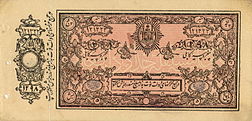 5 Afghan rupee banknote (1919) | |
| Unit | |
|---|---|
| Plural | rupees |
| Symbol | Re, Rs |
| Denominations | |
| Superunit | |
| 30 | habibi |
| 10 | tilla |
| 10 | amani |
| Subunit | |
| 1⁄60 | paisa |
| 1⁄12 | shahi |
| 1⁄6 | sanar |
| 1⁄3 | abbasi |
| 1⁄2 | kran, qiran |
| Plural | |
| paisa | paisas [1] |
| shahi | shahis [2] |
| sanar | sanars [3] |
| abbasi | abbasis [4] |
| kran, qiran | krans, [5] qirans |
| Banknotes | Re. 1/-, Rs. 5/-, Rs. 10/-, Rs. 50/-, Rs. 100/- |
| Demographics | |
| Date of introduction | 1891 |
| Replaced | Kabuli rupee Kandahari rupee |
| Date of withdrawal | 1923 [6] |
| Replaced by | Afghan afghani |
| User(s) | |
| This infobox shows the latest status before this currency was rendered obsolete. | |
The Afghan rupee was the currency of Afghanistan between 1891 and 1923. [6]

